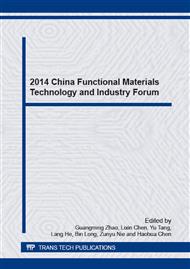p.682
p.689
p.697
p.702
p.707
p.711
p.719
p.724
p.731
Study on the Electric Properties of Carbon Fibers and its Application for the Preparation of Carbon/Carbon Composites
Abstract:
Acetylene (C2H2) was used as carbon source gas, nitrogen (N2) as dilution gas. The electric properties of carbon fibers was briefly discussed by energizing the carbon fibers in vacuum condition which were applied for the preparation of carbon/carbon composites by the method of chemical vapor deposition. The deposition mechanism and microstructure of pyrolytic carbons in carbon fibers under different deposition crafts were also discussed. Results indicate that the greater the initial voltage, the higher the temperature, we can change the deposition temperature by changing the initial voltage according to the relationship between the brightness and the surface temperature of carbon fibers. The surface of carbon fibers will be etched in the process of electrifying which would make the pyrolytic carbons preferred deposition on the etching point which became the growth center in the early deposition process. The pyrolytic carbons deposited with a spherical microcrystalline structure under the gas flow of C3H6/N2=2:3, When the rate of gas flow is C3H6/N2=1:2, The pyrolytic carbons deposited with a spherical microcrystalline structure after deposited for 0.5h, but after deposited for 1h, the deposition of large patches of molecular is dominant which lead to that: from a macro perspective, the pyrolytic carbons were a layered structure, From a microscopic perspective, they were a spherical microcrystalline structure with different size.
Info:
Periodical:
Pages:
707-710
Citation:
Online since:
December 2014
Authors:
Price:
Сopyright:
© 2015 Trans Tech Publications Ltd. All Rights Reserved
Share:
Citation:


